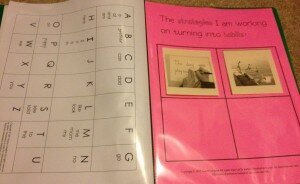
Student writing folders do an important job - they house our students' precious pieces! They have the potential to do much more, however... Here is how I use my students' folders to help them find ideas, improve their work, set goals, and measure their progress! First, I like to use poly folders with pockets and prongs. Over the years I have given up on paper folders, as writing folders really take a beating in the early grades. Poly folders stand up to so much more! The prongs are necessary to the tips that follow.
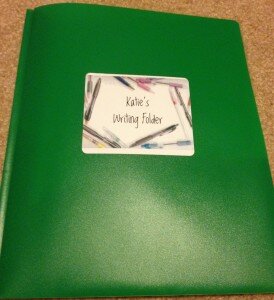
I start by inserting several page protectors in the prongs. I use three, as this really allows us to store up to six extra items, which is more than enough! Some of the sleeves will remain empty for a while, but that is fine.
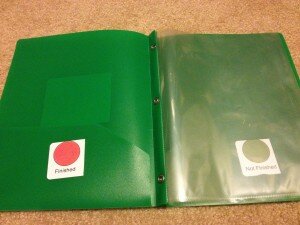
The first thing that we put into one of the sleeves is an inspiration page. This is a homework assignment early in the year. I ask the students to work with their families to create a page full of ideas. They can be photos, magazine clippings, drawings - whatever they like. The purpose is to give them a page full of ideas they can access if they ever feel that they do not have something to write about. I find that photos are the best, because they really help me to get to know the students as well. I might never have known that someone did a crazy science experiment, was a ballet dancer, went on a trip to Mount Rushmore, or has three sisters, but with the photos on the inspiration page, I know that I can call on these experiences to help students develop ideas. You can download the
inspiration page assignment that I send home if you are interested.
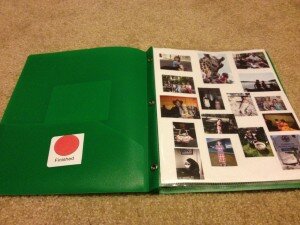
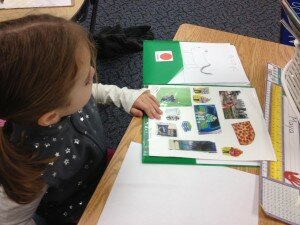
The next tool that we place in the writing folder is an alphabet anchor chart. I recommend using whatever chart you use in the classroom, so the students have some consistency. I find that having a chart right next to them as they are writing really encourages them to use it. They use this chart both as a reference tool for hearing and recording sounds, but also for correct handwriting. If you do not already have an
alphabet anchor chart, you can download the one I use for free!
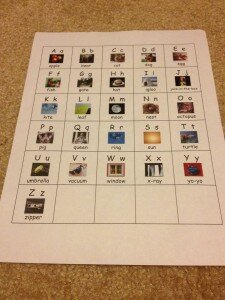
After we have worked with our word wall, I add a mini word wall to their writing folders as well. Once again, having it right next to them when they are writing encourages students to use it as a reference tool. I have a standard word wall chart that has the first twenty - five words my district uses. I often write in a few specific words for each child that I know are important for them. For example, if I know a student often writes about their soccer games, I might add the word "soccer" on that student's personal word wall. Here is my free
word wall words reference page. You can make it your own by downloading it as a
Word document.
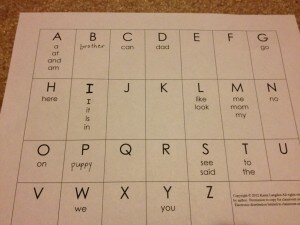
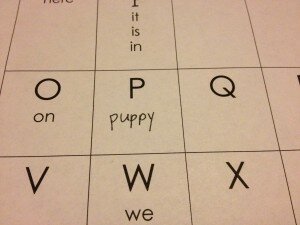
Finally, I have each student keep a goals/focus page in their writing folder. This is how it works. When conferencing with a student, I take note of my major teaching point. I draw a quick picture that will remind the student of that goal, and we place it on their strategies page. The plan is for them to practice this strategy until it becomes a habit. Any student may have up to four strategies on this page (fewer for students that have a harder time focusing). Then, when a student "masters" one of the strategies and is consistently using it in their work, I can remove the sticky note from their page.
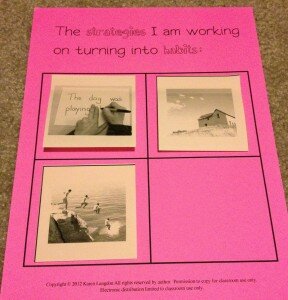
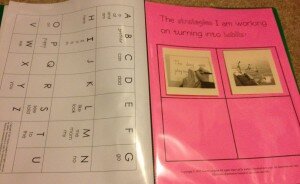
This page is multi-purpose. First, it encourages each child to think about him or herself as a writer. It forces them to notice what they are or are not consistently doing in their work. Second, it provides a concrete reminder about what they are working on as they write. Finally, it is a great record keeping tool. When I remove a sticky note from a student's page, I quickly write their name and the date on the note, and save it for record keeping purposes! This lets me know what they were working on, and when they mastered it. For example, in the photo below, "Katie" mastered adding setting to her drawings on Oct 16!
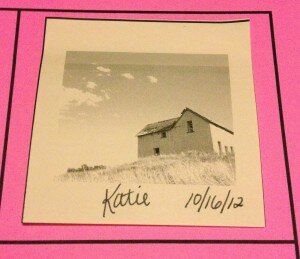
Because many teaching points are so global, I do have some pre-made sticky notes so I do not have to draw the same things over and over again. If you are interested you can download a
sticky notes template for some of these sticky notes, and you can download the free file for the
strategies and habits tracker.
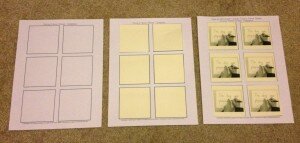
There you have it! Writing folders have so much potential to be a huge resource for our young writers, and a tool for us as teachers as well! What tools and anchor charts do your students have in their folders? This blog post was written by Karen Langdon, author of the Teaching Ace blog at
teachingace.com She is also the creator and sole owner of all free downloads offered in this post. Thanks for reading!
 Student writing folders do an important job - they house our students' precious pieces! They have the potential to do much more, however... Here is how I use my students' folders to help them find ideas, improve their work, set goals, and measure their progress! First, I like to use poly folders with pockets and prongs. Over the years I have given up on paper folders, as writing folders really take a beating in the early grades. Poly folders stand up to so much more! The prongs are necessary to the tips that follow.
Student writing folders do an important job - they house our students' precious pieces! They have the potential to do much more, however... Here is how I use my students' folders to help them find ideas, improve their work, set goals, and measure their progress! First, I like to use poly folders with pockets and prongs. Over the years I have given up on paper folders, as writing folders really take a beating in the early grades. Poly folders stand up to so much more! The prongs are necessary to the tips that follow. I start by inserting several page protectors in the prongs. I use three, as this really allows us to store up to six extra items, which is more than enough! Some of the sleeves will remain empty for a while, but that is fine.
I start by inserting several page protectors in the prongs. I use three, as this really allows us to store up to six extra items, which is more than enough! Some of the sleeves will remain empty for a while, but that is fine.  The first thing that we put into one of the sleeves is an inspiration page. This is a homework assignment early in the year. I ask the students to work with their families to create a page full of ideas. They can be photos, magazine clippings, drawings - whatever they like. The purpose is to give them a page full of ideas they can access if they ever feel that they do not have something to write about. I find that photos are the best, because they really help me to get to know the students as well. I might never have known that someone did a crazy science experiment, was a ballet dancer, went on a trip to Mount Rushmore, or has three sisters, but with the photos on the inspiration page, I know that I can call on these experiences to help students develop ideas. You can download the inspiration page assignment that I send home if you are interested.
The first thing that we put into one of the sleeves is an inspiration page. This is a homework assignment early in the year. I ask the students to work with their families to create a page full of ideas. They can be photos, magazine clippings, drawings - whatever they like. The purpose is to give them a page full of ideas they can access if they ever feel that they do not have something to write about. I find that photos are the best, because they really help me to get to know the students as well. I might never have known that someone did a crazy science experiment, was a ballet dancer, went on a trip to Mount Rushmore, or has three sisters, but with the photos on the inspiration page, I know that I can call on these experiences to help students develop ideas. You can download the inspiration page assignment that I send home if you are interested. 
 The next tool that we place in the writing folder is an alphabet anchor chart. I recommend using whatever chart you use in the classroom, so the students have some consistency. I find that having a chart right next to them as they are writing really encourages them to use it. They use this chart both as a reference tool for hearing and recording sounds, but also for correct handwriting. If you do not already have an alphabet anchor chart, you can download the one I use for free!
The next tool that we place in the writing folder is an alphabet anchor chart. I recommend using whatever chart you use in the classroom, so the students have some consistency. I find that having a chart right next to them as they are writing really encourages them to use it. They use this chart both as a reference tool for hearing and recording sounds, but also for correct handwriting. If you do not already have an alphabet anchor chart, you can download the one I use for free!  After we have worked with our word wall, I add a mini word wall to their writing folders as well. Once again, having it right next to them when they are writing encourages students to use it as a reference tool. I have a standard word wall chart that has the first twenty - five words my district uses. I often write in a few specific words for each child that I know are important for them. For example, if I know a student often writes about their soccer games, I might add the word "soccer" on that student's personal word wall. Here is my free word wall words reference page. You can make it your own by downloading it as a Word document.
After we have worked with our word wall, I add a mini word wall to their writing folders as well. Once again, having it right next to them when they are writing encourages students to use it as a reference tool. I have a standard word wall chart that has the first twenty - five words my district uses. I often write in a few specific words for each child that I know are important for them. For example, if I know a student often writes about their soccer games, I might add the word "soccer" on that student's personal word wall. Here is my free word wall words reference page. You can make it your own by downloading it as a Word document. 
 Finally, I have each student keep a goals/focus page in their writing folder. This is how it works. When conferencing with a student, I take note of my major teaching point. I draw a quick picture that will remind the student of that goal, and we place it on their strategies page. The plan is for them to practice this strategy until it becomes a habit. Any student may have up to four strategies on this page (fewer for students that have a harder time focusing). Then, when a student "masters" one of the strategies and is consistently using it in their work, I can remove the sticky note from their page.
Finally, I have each student keep a goals/focus page in their writing folder. This is how it works. When conferencing with a student, I take note of my major teaching point. I draw a quick picture that will remind the student of that goal, and we place it on their strategies page. The plan is for them to practice this strategy until it becomes a habit. Any student may have up to four strategies on this page (fewer for students that have a harder time focusing). Then, when a student "masters" one of the strategies and is consistently using it in their work, I can remove the sticky note from their page. 
 This page is multi-purpose. First, it encourages each child to think about him or herself as a writer. It forces them to notice what they are or are not consistently doing in their work. Second, it provides a concrete reminder about what they are working on as they write. Finally, it is a great record keeping tool. When I remove a sticky note from a student's page, I quickly write their name and the date on the note, and save it for record keeping purposes! This lets me know what they were working on, and when they mastered it. For example, in the photo below, "Katie" mastered adding setting to her drawings on Oct 16!
This page is multi-purpose. First, it encourages each child to think about him or herself as a writer. It forces them to notice what they are or are not consistently doing in their work. Second, it provides a concrete reminder about what they are working on as they write. Finally, it is a great record keeping tool. When I remove a sticky note from a student's page, I quickly write their name and the date on the note, and save it for record keeping purposes! This lets me know what they were working on, and when they mastered it. For example, in the photo below, "Katie" mastered adding setting to her drawings on Oct 16!  Because many teaching points are so global, I do have some pre-made sticky notes so I do not have to draw the same things over and over again. If you are interested you can download a sticky notes template for some of these sticky notes, and you can download the free file for the strategies and habits tracker.
Because many teaching points are so global, I do have some pre-made sticky notes so I do not have to draw the same things over and over again. If you are interested you can download a sticky notes template for some of these sticky notes, and you can download the free file for the strategies and habits tracker.  There you have it! Writing folders have so much potential to be a huge resource for our young writers, and a tool for us as teachers as well! What tools and anchor charts do your students have in their folders? This blog post was written by Karen Langdon, author of the Teaching Ace blog at teachingace.com She is also the creator and sole owner of all free downloads offered in this post. Thanks for reading!
There you have it! Writing folders have so much potential to be a huge resource for our young writers, and a tool for us as teachers as well! What tools and anchor charts do your students have in their folders? This blog post was written by Karen Langdon, author of the Teaching Ace blog at teachingace.com She is also the creator and sole owner of all free downloads offered in this post. Thanks for reading!
No comments:
Post a Comment